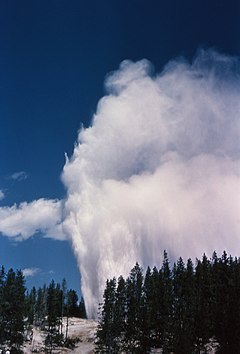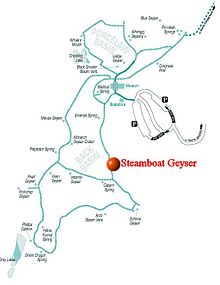
Back Steamboat Geyser (tubud sa Tinipong Bansa, lat 44,72, long -110,70) CEB Steamboat Geyser Czech Steamboat Geyser Danish Steamboat-Geysir German Steamboat Geyser Finnish Steamboat Geyser French גייזר ספינת הקיטור HE Steamboat Geyser Dutch Steamboat Geyser Polish Gheizerul Steamboat Romanian
| Steamboat Geyser | |
|---|---|
 Major eruption, Steamboat Geyser, circa 1960s | |
 | |
| Location | Norris Geyser Basin, Yellowstone National Park, Park County, Wyoming |
| Coordinates | 44°43′25″N 110°42′11″W / 44.7236795°N 110.7031823°W[1] |
| Elevation | 7,598 feet (2,316 m)[2] |
| Type | Cone geyser |
| Eruption height | 300 to 400 feet (91 to 122 m) |
| Frequency | 3 days to 50 years |
| Duration | 3 to 129 minutes |
| Temperature | 71.3 °C (160.3 °F) on 1998-06-26[1] |
 Norris Geyser Basin | |
Steamboat Geyser, in Yellowstone National Park's Norris Geyser Basin, is the world's tallest active geyser. Steamboat Geyser has two vents, northern and southern, approximately 20 feet (6.1 m) apart. The north vent is responsible for the tallest water columns; the south vent's water columns are shorter.[3]
Prior to 1904, Waimangu Geyser, in New Zealand, had some taller eruptions capable of reaching 1,600 feet (490 m), but in 1904, a landslide changed the local water table, and since then, Waimangu has not erupted.[4] Excelsior Geyser in Yellowstone's Midway Geyser Basin, and Semi-Centennial Geyser just north of Roaring Mountain on the Grand Loop Road were reported to be as tall as Steamboat, both with eruptions reaching 300 ft (91 m).[5] However, Excelsior has not erupted since 1985, and functions as a hot spring, and Semi-Centennial's one eruption of this height was reported in 1922 and it has been dormant since.
Steamboat's major eruptions generally last from 3 to 40 minutes (several durations surpassing an hour were observed during the 2018 active phase[6]), and are followed by powerful jets of steam. During these eruptions, water may be thrown more than 300 feet (91 m) into the air.[7] Steamboat does not erupt on a predictable schedule, with recorded intervals between major eruptions ranging from three days to fifty years. The geyser was dormant from 1911 to 1961. In 1964, twenty-nine eruptions were reported,[8] setting a record for the most eruptions within a calendar year. In 2018, the geyser began a prolonged period of frequent activity lasting through at least 2022, with more than 40 eruptions recorded annually in both 2019 and 2020.
Minor eruptions of 10 to 15 feet (3.0 to 4.6 m) are much more frequent.
After an eruption, the geyser often vents large amounts of steam for up to 48 hours.[9] Sometimes during this part of an eruption, water may return to Steamboat, causing it to jet water once again, though to lesser heights.[6] Cistern Spring, located nearby, will drain completely following a major eruption of the geyser; the spring refills within a few days.
- ^ a b "Steamboat Geyser". Yellowstone Geothermal Features Database. Montana State University.
- ^ "Steamboat Geyser". Geographic Names Information System. United States Geological Survey, United States Department of the Interior.
- ^ Jones, Janet (28 April 2018). "Watching Steamboat Geyser". Retrieved June 25, 2019.
- ^ Jones, Gregory L. "Tall Geysers". WyoJones' Geyser Pages. Archived from the original on April 2, 2009. Retrieved May 24, 2006.
- ^ "Yellowstone Celebrates With a New Geyser". National Parks Magazine (30). November 8, 1922. Retrieved April 12, 2019.
- ^ a b Cite error: The named reference
GeyserTimeswas invoked but never defined (see the help page). - ^ Bryan, T. Scott (May 1995). The Geysers of Yellowstone (3rd ed.). University Press of Colorado. ISBN 0-87081-365-X.
- ^ "Steamboat Geyser" (PDF). National Park Service. August 2013. Retrieved 2016-04-18.
- ^ "Steamboat Geyser". National Park Service.
© MMXXIII Rich X Search. We shall prevail. All rights reserved. Rich X Search